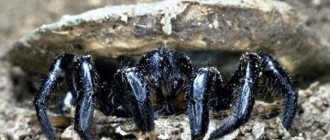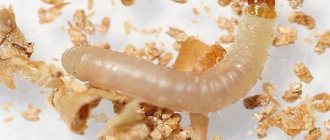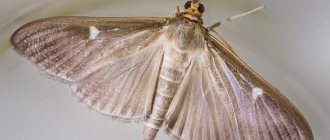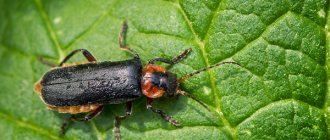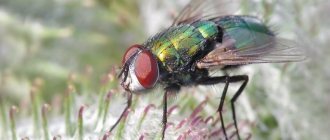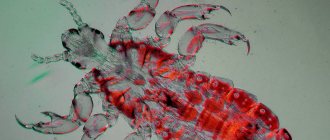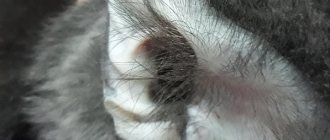What does it consist of and where is it formed?
The composition of the web includes the following substances:
- organic compounds - fibroin protein, which makes up the main internal thread, and glycoproteins that form nanofibers located around the main thread. Thanks to fibroin, the web is similar in composition to silk, but much more elastic and stronger;
- inorganic substances - chemical compounds of potassium (hydrogen phosphate and nitrate). Their number is small, but they give the web antiseptic properties and protect it from fungi and bacteria, creating a favorable environment in the spider’s glands for the formation of threads.
In the abdomen of the spider there are arachnoid glands, where a liquid substance is formed that comes out through spinning tubes located on the arachnoid warts. They can be observed at the very bottom of the abdomen.
A viscous liquid comes out of the tube and quickly hardens in air. Using its hind legs, the spider pulls out the thread and uses it for weaving. One spider is capable of producing a thread 0.5 km long. Did you know? Our most common spider, the cross spider, weaves the most famous round trapping web. The spider always weaves a structure of 39 rays, on which there are 35 spiral circles with 1245 fasteners. Cross workers do this work at night and update the network every 1–2 days.
Composition and properties of the web
Spider web is a protein compound that also contains glycine, alanine and serine. The inner part of the formed threads is represented by hard protein crystals, the size of which does not exceed several nanometers. The crystals are held together by highly elastic protein bonds.
This is interesting! An unusual property of the web is its internal articulation. When hung on a spider's web, any object can be rotated an unlimited number of times without twisting.
The primary threads are intertwined by the spider and become thicker spider fibers. The strength indicators of the web are close to those of nylon, but are much stronger than the secretion of the silkworm. Depending on the purpose for which the web is intended to be used, the spider can produce not only sticky, but also dry thread, the thickness of which varies significantly.
How different types of spiders use webs
In nature, there are tenet spiders that weave hunting webs (teneta), but non-netet species are also known that hunt without using a web. But they produce webs during periods of molting, resting, molting, and wintering. Spiders weave protective bags or shelters woven from cobwebs.
Web spiders escape when a predator approaches on a web thread, falling down. When the danger has passed, they return back to the web thread and rise up, quickly reeling in their safety rope.
What do spiders eat?
This is a fundamentally important question, since a spider weaves a web primarily to obtain food. Note that all species of spiders, without exception, are predators. However, their diet varies greatly depending on their size, hunting methods, and location. All tenet (web-weaving) spiders are insectivorous, and their diet is based primarily on flying forms.
Although if a crawling character falls onto the web from a tree, its owner will not disdain him. Those who live in burrows and closer to the ground eat mainly orthoptera and beetles, although they may drag a small snail or worm into their shelter. Among the diversity of what spiders feed on, there are also larger objects.
For the aquatic representative of the tribe called Argyroneta, crustaceans, aquatic insects and fish fry become victims. Exotic giant tarantulas prey on frogs, birds, small lizards and mice, although most of their diet consists of the same insects. But there are also more fastidious species. Members of the family Mimetidae hunt only spiders that do not belong to their species.
Where does a spider's web come from?
On the abdomen of the arthropod there are outgrowths - arachnoid warts. In their upper part, the channels of the arachnoid glands open, forming threads. There are 6 types of glands that produce silk for different purposes (moving, lowering, entangling prey, storing eggs). In one species, all these organs do not occur at the same time; usually an individual has 1-4 pairs of glands.
On the surface of warts there are up to 500 spinning tubes that supply protein secretion. The spider spins its web as follows:
- spider warts are pressed against the base (tree, grass, wall, etc.);
- a small amount of protein adheres to the selected location;
- the spider moves away, pulling the thread with its hind legs;
- for the main work, long and flexible front legs are used, with their help a frame is created from dry threads;
- The final stage of making the network is the formation of sticky spirals.
Thanks to the observations of scientists, it became known where the spider’s web comes from. It is produced by movable paired warts on the abdomen.
Interesting fact. The web is very light; the weight of a thread wrapping the Earth along the equator would be only 450 g.
Where does it come from?
Spiders are the oldest creatures, living on earth for more than two hundred million years. Without their web, they, perhaps, would not be so interesting to humanity. So where do spiders’ webs come from and what does it look like?
The web is the contents of special glands that many arthropods have (false scorpions, spiders, spider mites, etc.). The liquid contents can be stretched without tearing. The resulting thin threads harden very quickly in air.
Each spider has several specific glands on its body that are responsible for producing webs. Different glands form webs of different types and densities. They are located on the abdomen in the form of very thin ducts and are called “spider warts”. It is from these holes that a liquid secretion is released, which soon turns into a beautiful web.
With the help of its paws, the spider distributes and “hangs” the web where it needs it. The spider's front legs are the longest, and they play the main role. And with the help of its hind legs, it grabs drops of liquid and stretches them to the required length.
How to build a fishing net
The wind is the spider's best assistant in construction. Having taken out a thin thread from the warts, the arachnid exposes it to an air flow, which carries the frozen silk over a considerable distance. This is the secret way a spider weaves a web between trees. The web easily clings to tree branches, using it as a rope, the arachnid moves from place to place.
A certain pattern can be traced in the structure of the web. Its basis is a frame of strong and thick threads arranged in the form of rays diverging from one point. Starting from the outer part, the spider creates circles, gradually moving towards the center. It is amazing that without any equipment it maintains the same distance between each circle. This part of the fibers is sticky and is where insects will get stuck.
Interesting fact. The spider eats its own web. Scientists offer two explanations for this fact - in this way, the loss of protein during the repair of the fishing net is replenished, or the spider simply drinks water hanging on the silk threads.
The complexity of the web pattern depends on the type of arachnid. Lower arthropods build simple networks, while higher ones build complex geometric patterns. It is estimated that the female crosstail builds a trap of 39 radii and 39 spirals. In addition to smooth radial threads, auxiliary and catcher spirals, there are signal threads. These elements capture and transmit to the predator the vibrations of the caught prey. If a foreign object (a branch, a leaf) comes across, the little owner separates it and throws it away, then restores the net.
Large arboreal arachnids pull traps with a diameter of up to 1 m. Not only insects, but also small birds fall into them.
Why do spiders build trapping webs?
The ability to produce a patina is not a primary characteristic of spiders, but web-weaving has become a distinctive feature of arachnids. Spiders are true predators, waiting for their prey in a secluded place.
Thanks to the adhesive properties of the web, a wide variety of animals, ranging from insects and even small birds, get caught in spider webs.
Having stuck to the web, the victim tries to get out of the trap by swinging the web thread. The resulting vibrations are transmitted along the signal thread to the spider, which quickly approaches the prey along the threads and injects digestive juice, which, upon entering the victim, digests the internal contents. Then the spider weaves a web around it, forming something like a cocoon. It remains to wait a little until the digestive enzymes make it possible to simply suck out the liquid contents.
Wind to the rescue
The breeze also contributes to the correct distribution of the web. If the spider chooses the right place to place itself, for example between trees or in leaves, then the wind helps to carry the threads where they need to be. If you wanted to answer the question for yourself about how a spider weaves a web between trees, then here is the answer. The wind helps him.
When one thread catches on the desired branch, the spider crawls, checks the strength of the base and releases the next one. The second is attached to the middle of the first and so on.
Differences in webs by spider species
Depending on the species, spiders can weave different webs, which are a kind of “calling card” of the arthropod.
Round web
This version of the web looks incredibly beautiful, but is a deadly design. As a rule, a round web is suspended in a vertical position and has part of the adhesive threads, which does not allow the insect to escape from it. Weaving such a network is carried out in a certain sequence. At the first stage, the outer frame is made, after which radial fibers are laid from the central part to the edges. Spiral threads are woven at the very end.
This is interesting! A medium-sized circular web has more than a thousand point connections, and its production requires more than twenty meters of spider silk, which makes the structure not only very light, but also incredibly durable.
Information about the presence of prey in such a trap comes to the “hunter” through specially woven signal threads. The appearance of any breaks in such a web forces the spider to weave a new web. Old webs are usually eaten by arthropods.
Strong web
This type of web is characteristic of nephilous spiders, which are widespread in Southeast Asia. The trapping nets they build often reach a couple of meters in diameter, and their strength allows them to easily support the weight of an adult.
Such spiders catch in their strong web not only ordinary insects, but also some small birds. Research results show that spiders of this type can produce about three hundred meters of spider silk daily.
Functions of the web and its purpose
Webs are used by spiders for a variety of purposes. A shelter woven from a strong and reliable web allows you to create the most favorable microclimatic conditions for arthropods, and also serves as a good shelter both from bad weather and from numerous natural enemies. Many arthropod arachnids are capable of weaving their web around the walls of their burrow or making it into a kind of door into their home.
This is interesting! Some species use webs as transport, and young spiders leave the parental nest on long web threads, which are picked up by the wind and transported over considerable distances.
Most often, spiders use webs to weave sticky trapping networks, which allows them to effectively catch prey and provide food to the arthropod. No less famous are the so-called egg cocoons made from webs, inside which young spiders appear. Some species weave web-like safety threads that protect arthropods from falling while jumping and for moving or catching prey.
Web for reproduction
The breeding season is characterized by the release of arachnoid threads by the female, which make it possible to find the optimal pair for mating. For example, male web-slingers are capable of constructing, next to the nets created by females, miniature mating web laces into which spiders are lured.
Male cross spiders deftly attach their horizontal webs to radially arranged strands of trapping webs made by females. By striking the web with strong blows with their limbs, the males cause the web to vibrate and, in this unusual way, invite the females to mate.
Home for posterity
Cocoons for eggs are woven from the silky web secretion. Their number, depending on the type of arthropod, is 2-1000 pieces. The females hang the web sacs with eggs in a safe place. The cocoon shell is quite strong; it consists of several layers and is impregnated with liquid secretion.
In their burrow, arachnids weave webs around the walls. This helps create a favorable microclimate and serves as protection from bad weather and natural enemies.
Moving
One of the answers to why a spider weaves a web is that it uses threads as a vehicle. To move between trees and bushes, quickly understand and fall, it needs strong fibers. To fly over long distances, spiders climb to elevated heights, release a quickly hardening web, and then with a gust of wind they fly away for several kilometers. Most often, trips are made on warm, clear days of Indian summer.
Hunting for prey
Building webs to catch prey is one of the reasons why spiders need to make webs. Its ability to immobilize the victim depends on the structure of the web. Some species of predators are so small that they themselves become prey to large insects. The poison introduced by the spider into the body of the victim does not act immediately. To prevent the prey from escaping, the predator takes it and wraps it in fiber, after which it waits for the prey’s insides to turn into a liquid state.
If you compare a spider's web and human hair, the former will be thinner. It is comparable in strength to steel wire.
Attracting males
Some types of female arachnids secrete a web secretion containing pheromones during the breeding season. This “mark” attracts the male. Signaling fibers are formed by most species, but in some the initiative comes from the male.
In search of a female for reproduction, males weave a sperm net onto which they first secrete a drop of seminal fluid. To attract a female, males attach their threads to the female’s web and set it in motion. This is how they tell her the purpose of their stay. To mate, the female goes into the male’s web space.
Web for insurance
Jumping spiders use web threads as insurance when attacking a victim. Spiders attach a safety thread of the web to any object, after which the arthropod jumps on the intended prey. The same thread, attached to the substrate, is used for overnight shelter and protects the arthropod from attacks by all kinds of natural enemies.
This is interesting! South Russian tarantulas, leaving their burrow home, pull behind them a thin web thread, which allows them to quickly find the way back or the entrance to the shelter if necessary.
Web as transport
By autumn, some species of spiders hatch their young. Young spiders that survive the process of growing up try to climb as high as possible, using trees, tall bushes, roofs of houses and other buildings, fences for this purpose. Having waited for a sufficiently strong wind, the small spider releases a thin and long web.
The distance of movement directly depends on the length of such a transport web. Having waited for a good tension of the web, the spider bites off its end and takes off very quickly. As a rule, “travelers” are able to fly several kilometers on a web.
Silver spiders use webs as water transport. To hunt in bodies of water, this spider requires breathing atmospheric air. When descending to the bottom, the arthropod is able to capture a portion of air, and on aquatic plants, a kind of air bell is constructed from the web, which retains air and allows the spider to hunt its prey.
Distracting the attention of predators
Orb-weavers create distracting dummies from nets by gluing leaves and twigs with cobwebs. They place a “decoy” on their web, thereby trying to mislead the predator. The animal hides not far from the dummy and pulls the threads, making deceptive movements with them.
For the first time, a spider capable of making its own double was discovered in the Amazon forests by biologist Phil Torres. He came across a web with what he thought was a strange spider. At first the biologist thought it was dead, but when he got closer, he discovered that it was an elaborate replica made from leaves. The creator of the bait was waiting for prey in another place.
Design features of the web
Design features of the web
The purpose of a spider's life is to obtain protein food. The answer to the question “Why do spiders weave webs” is obvious. Primarily for hunting insects. They make a trapping net of complex design. The appearance of the patterned structures is different.
- Most often we see polygonal networks. Sometimes they are almost round. Weaving from spiders requires incredible skill and patience. Sitting on the top branch, they form a thread that hangs in the air. If you're lucky, the thread will quickly catch on a branch in a suitable place and the spider will move to a new point for further work. If the thread does not catch in any way, the spider pulls it towards itself, eats it so that the product does not disappear, and begins the process again. Gradually forming a frame, the insect begins to create radial bases. When they are ready, all that remains is to make connecting threads between the radii;
- Funnel representatives have a different approach. They make a funnel and hide at the bottom. When the victim approaches, the spider jumps out and pulls it into the funnel;
- Some individuals form a network of zigzag threads. The likelihood that the victim will not get out of such a pattern is much greater;
- The spider called “bola” does not bother itself; it weaves only one thread, which has a drop of glue at the end. The hunter shoots a thread at the victim, gluing it tightly;
- Spider-ogres turned out to be even more cunning. They make a small net between their paws, then throw it over the desired object.
Designs depend on the living conditions of insects and their species.
Purpose of the web
Fine nets are not only insect traps. The role of the web in the life of arachnids is much broader.
Catching prey
All spiders are predators, killing their prey with poison. Moreover, some individuals have a fragile constitution and can themselves become victims of insects, for example, wasps. To hunt, they need shelter and a trap. Sticky fibers perform this function. They entangle the prey caught in the net in a cocoon of threads and leave it until the injected enzyme brings it into a liquid state.
Arachnid silk fibers are thinner than human hair, but their specific tensile strength is comparable to steel wire.
Reproduction
During the mating period, males attach their own threads to the female's web. By striking the silk fibers rhythmically, they communicate their intentions to a potential partner. The female receiving courtship descends onto the male’s territory to mate. In some species, the female initiates the search for a partner. She secretes a thread with pheromones, thanks to which the spider finds her.
Home for posterity
Cocoons for eggs are woven from the silky web secretion. Their number, depending on the type of arthropod, is 2-1000 pieces. The females hang the web sacs with eggs in a safe place. The cocoon shell is quite strong; it consists of several layers and is impregnated with liquid secretion.
In their burrow, arachnids weave webs around the walls. This helps create a favorable microclimate and serves as protection from bad weather and natural enemies.
Moving
One of the answers to why a spider weaves a web is that it uses threads as a vehicle. To move between trees and bushes, quickly understand and fall, it needs strong fibers. To fly over long distances, spiders climb to elevated heights, release a quickly hardening web, and then with a gust of wind they fly away for several kilometers. Most often, trips are made on warm, clear days of Indian summer.
The role of the web in the life of a spider
A web is not only a trapping net with which a spider entangles its prey. Her role is much more important. Realization of the reproductive instinct is one of the main goals, which is why spiders weave their webs. Females use it to attract a male, leaving pheromones on the threads.
Male araneomorph spiders, on the eve of the mating season, weave a special spermatic net onto which they secrete seminal fluid for subsequent transfer to a special reservoir on the forelimbs-tentacles (pedipalps). They are also the organ of copulation.
Egg cocoons are also woven from the web. Some of them have a very complex barrier structure. The bacteriostatic properties of the web protect the eggs from the effects of mold, bacteria and drying out.
Another reason why spiders need webs is for protection. Adults hide in web cocoons during molting periods. At this time they are most vulnerable, and the dense, breathable cover reliably protects them from external factors.
Water spiders create a cocoon from web threads to collect air bubbles. Many species cover the walls of their home with fibers and weave around the entrance to it.
Spiders use web threads to create safety structures in their habitat and hunting area in order to cling in case of a fall. Orb-weaving spiders roll up a dummy from webs and small debris and hang it on a fishing net as bait.
The spider periodically eats the web (usually when repairing damage). There are 2 versions of why he does this: 1 – replenishing protein in the body, 2 – obtaining water that settles during precipitation.
The web also serves to spread the population. Young spiders of some species leave their nests in the fall on thin spider webs carried by the wind.
Upon closer inspection, the spider is a unique spinning mini-factory and an interesting object to observe.
These are predators that could not be forced to produce silk for human use, like silkworms. Scientists are close to creating such threads in artificial conditions, but this goal has not yet been achieved.
Where do spiders get their webs from?
In the abdominal cavity of spiders there are special arachnoid glands. There are a lot of them. The ducts of these glands open into tiny spinning tubes at the ends of six arachnoid warts on the spider's abdomen. The cross spider, for example, has about 500-550 such tubes. The arachnoid glands produce a liquid viscous substance (secret) consisting of protein. This secret has the ability to instantly harden in air. Therefore, when the protein secretion of the arachnoid glands is secreted through the spinning tubes, it hardens in the form of thin threads.
12 1. Cross spider (with an open abdominal cavity) 2. Spider arachnoid warts
The spider begins to spin its web like this: it presses the spider warts to the place where it is going to start weaving the web. In this case, a small portion of the released secretion, solidifies, sticks to this place. The spider then continues to pull out the viscous secretion from the web tubes using its hind legs. When it moves away from the attachment site, the rest of the secretion simply stretches into quickly hardening threads.
Spiders use webs for a variety of purposes. In the web shelter, the spider finds a favorable microclimate, where it also takes refuge from enemies and bad weather. Some spiders weave webs around the walls of their burrows. The spider weaves sticky trapping nets from its web to capture prey. Egg cocoons, in which eggs and young spiders develop, are also made from cobwebs. Pooks also use webs for travel—little Tarzans use it to weave safety threads that protect them from falling when jumping. Depending on the purpose of use, the spider can secrete sticky or dry thread of a certain thickness.
In terms of chemical composition and physical properties, cobwebs are close to the silk of silkworms and caterpillars, only it is much stronger and more elastic: if the breaking load for caterpillar silk is 33-43 kg per 1 mm 2, then for cobwebs it is from 40 to 261 kg per mm 2 (depending on the type)!
Other arachnids, such as spider mites and pseudoscorpions, can also produce webs. However, it was spiders who achieved true mastery in weaving webs. After all, it is important not only to be able to make a web, but also to produce it in large quantities. In addition, the “loom” should be located in a place where it is more convenient to use. In pseudoscorpions and spider mites, the raw material base of the web is located. in the head, and the weaving apparatus is on the oral appendages. In conditions of the struggle for existence, animals whose heads are weighed down with brains, and not with cobwebs, gain an advantage. That's what spiders are. The spider's abdomen is a real web factory, and the spinning devices - arachnoid warts - are formed from atrophied abdominal legs on the underside of the abdomen. And the spiders’ limbs are simply “golden” - they spin so deftly that any lacemaker would envy them.
Candidate of Physical and Mathematical Sciences E. Lozovskaya
Web weaving technology
As a rule, many species of spiders prefer to be nocturnal, so they weave webs mainly at night. On average, a spider spends about an hour on this procedure. If you need to repair an insect trap, it takes even less time.
Below you can see in the video how a spider weaves a web and how much time it takes him to do it. If the web is torn off, then the next morning exactly the same web will appear in the same place. The most beautiful webs are produced by orb weavers. Using strong threads, the spider forms a triangle, after which it fills it with cells of a certain size.
Interesting to know! In the tropical forests of Brazil lives a tarantula spider that weaves such a strong web that local fishermen use it as nets to catch fish. From spider threads you can weave not only a thin, but also a fairly strong fabric. Some companies make body armor from spider substances.
In the garden you can see how the spider weaves a web, placing it on 2 trees. This could be an openwork fishing net or a funnel that glitters in the sun, attracting insects. Of course, for many this process is a mystery. It is even difficult to imagine how the spider was able to stretch its web between two trees. As a rule, a spider flies on a web from one tree to another under the influence of the wind. Having secured the second end, the simplest thing he can do is fill the space with cells.
At the same time, while in a state of flight, the spider controls the distance to the neighboring tree, while adjusting the length of the web. Sometimes, in order to catch on to a branch, he simply shoots a web at the right place.
The spider weaves a web. Watch this video on YouTube
Cobwebs in the house - signs
According to popular belief, a lot of cobwebs in the house is a sign of wealth.
. However, it is useless not to specifically remove and leave a spider web throughout the apartment. This won't work.
In addition, for money and prosperity to come, comfort and harmony must reign in the family. Only then will the web be able to catch and delay good luck. Where there is misunderstanding, quarrels and discord in family relationships, such a sign about the web will not work. And the spiders themselves do not live long in such houses and apartments.
Waking up in the morning to see that a spider has woven a web on the ceiling right above the bed
, is a sign of quick success in some business. According to popular beliefs, it is recommended not to remove the woven spider web until the omen comes true.
According to signs, there are cobwebs in the corners of the apartment
indicates places where a lot of negative energy has accumulated. So the spider tells you where exactly the evil spirits have gathered, and where the house should be cleansed with a candle and prayer.
See a cobweb above the front door
or behind it is a sign of rumors and gossip. You should prepare for the fact that ill-wishers are weaving networks of intrigue behind your back.
Cobwebs found above or behind a door inside a house or apartment
, warns of deception and lies. If a young girl finds a web in such a place, this is a sign that her beloved guy is cheating. Under no circumstances should such a web be removed, as this can only worsen the situation.
See cobwebs in the kitchen
, for example, near the table; behind the stove, sink or wall cabinet; near the leg of a stool or near the windowsill, which means that the mistress of the house will soon have an assistant.
You can make a talisman from a cobweb found in your apartment. To do this, you need to carefully fold the collected web into a small canvas bag (sewn with your own hands and without a sewing machine). This amulet should be carried with you constantly - it will protect against all troubles and attract good luck.
Our ancestors believed that a spider weaves a web in the corner of the window.
- for good weather. It was believed that the coming day would be warm and without precipitation. However, this sign comes true if in such a web the spider itself sits in its center. If there is no spider in the web, this is a sign of rain.
If by chance hit the cobwebs on the window
, is a sign of a quick meeting with an old friend.
Accidentally tearing off a cobweb woven on a window
, - to a major quarrel with a loved one.
According to signs about spiders, see a torn web on the window
, - bad sign. This means that there will be a series of failures ahead both in your personal life and in finances.
To protect yourself from a bad omen, you need to carefully remove the spider’s web with a cloth (while trying to keep the spider itself alive), and then wash your hands and say: “All the bad things, go away, but the good things, stay with me.”
Cobwebs twisted outside the window
, protects from the evil eye and damage. However, she also warns that the inhabitants of the house have ill-wishers who spread gossip and lead intrigues.
See a spider weaving a web in your apartment
(wherever it is) is a generally good omen. But you can’t just tear off the spider’s web with your hands or a broom. It is better to carefully collect it and leave it outside the house.
Why doesn't the spider stick to its web?
For a successful hunt, the spider must be able to move quickly and unhindered along the woven web. And he succeeds very well. Unlike its victims, the hunter does not stick to the threads and easily moves along them.
Spider's foot
He succeeds due to several factors:
- The spider's legs have many elastic hairs and claws. Moving along the web, the arthropod clings with its claws, pressing the thread to the hairs. When the spider lifts its leg, the claw unclenches and the hairs straighten, pushing away the web.
- The tips of the spider's legs are covered with a special oily substance.
- The predator moves along dry threads, which it specially weaves into a network to facilitate its movement.
Most often, in the center of the web there is a safe area where the spider waits for its victim.
